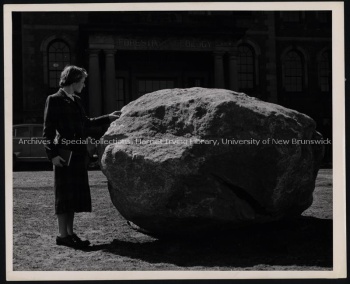Previously named: Chemistry and Natural Science, Geology and Natural History, Geology and Mineralogy, Geology
Established: 1941
History: The history of Earth Sciences at UNB began with the appointment of James Robb as the Professor of Chemistry and Natural Science in 1837. Loring Woart Bailey, an active geologist, assumed the position of Chair of Chemistry and Natural Science in 1861 following Robb's death. Studying geology was initially restricted to fourth year students, and specified courses were offered under 'Natural Science' from the 1860s until 1907, when Philip Cox became the Professor of Geology and Natural History. Geology was later taught separately from the Natural Science discipline in the 1930s, and re-named Geology and Mineralogy. Ordinary courses were offered in the third and fourth years and included courses such as Elementary Geology, Historical Geology, Economic Geology, and Rock Analysis with labs every week. Mineralogy was only offered as an honour course in the fourth year and focused on the study of Crystallography, Elementary Mineralogy, and so on. Other geology courses specifically designed for engineers also appeared in the 1930s, such as Engineering Geology for civil engineers and foresters in their third year.
The Department of Geology and Mineralogy was established in 1941 and offered seven courses. During the Second World War, the science departments at UNB all struggled to expand and achieve further scientific advances due to a lack of funding and popular support. These departments, which included Geology and Mineralogy, found eventual support from the increasing undergraduate enrollment following the war's end. The number of course offerings under Geology and Mineralogy grew to fourteen by 1950. Some of the course offerings throughout the 1950s included Mineralogy, Paleontology, Physiography, and Geomorphology and the Geology of Canada. The department experienced a slight name change in the early 1960s, going from 'Geology and Mineralogy' to simply 'Geology'. It wasn't until the 1970s that the curriculum expanded more drastically, with thirty-five course offerings. Newer courses included Principles of Stratigraphy and Sedimentology, Petrology, Principles of Geochemistry, Biogeology, Tectonophysics, and Ore Mineralogy. A significant increase occurred in the 1980s, with forty-six courses, along with the introduction of the Geological Engineering program in the 1987-1988 academic year.This program was established by both the Department of Civil Engineering and Department of Earth Sciences and it involves studying the exploration, conservation, and utilization of earth materials and the resources of the earth's crust. It began with only three courses in its first year, including Senior Report I and II, and Groundwater Engineering. Four more courses were added within the following two years: Geology for Engineers, Applied Glacial Geology, Applied Rock Mechanics, and Rock Mechanics Design. Two options were available under the Geological Engineering program which were Mineral Resources and Geotechnical. A third option was added in the 1995-96 year, named the Geoenvironmental option. As a whole the Department of Geology experienced less growth during the 1990s, with courses averaging at forty-seven offerings. The Geological Engineering program expanded slightly with nine courses offered for much of the decade. In the 1997-98 year, there were eleven courses offered under this program, while eleven instructors taught all courses under the Geology department.
The early 2000s brought about some growth within the department, with fifty-one courses in the 2004-05 academic year, including newer offerings such as Isotope Geochemistry, Volcanology, Metamorphic Petrology, and Physical Geochemistry. The Geological Engineering program continued, but courses were again only at nine options by 2008. In the 2012-2013 academic year, the Department of Geology was re-named Earth Sciences and there were forty-seven courses and eighteen instructors, along with eight courses offered through the Geological Engineering program.
Physical location: Forestry and Geology Building
Faculty: Science
Notes: The year that a certain department was established can be a subjective figure. For the purpose of this wiki, the year that a department is considered first established is the first year it was listed in the academic calendar as an independent chair with no other affiliation, unless documentation can demonstrate otherwise.
Source(s):
- Toole, F.J. “Chapter VI: The Scientific Tradition”. The University of New Brunswick Memorial Volume. Ed. Alfred G. Bailey. Fredericton: University of New Brunswick, 1950. 69-74.
- UNB Calendars (UA RG 86) 1861, 1900, 1907, 1909, 1930, 1931, 1932, 1941, 1949-50, 1952-53, 1955-56, 1962-63, 1972-73, 1978-79, 1983-84, 1987-88, 1988-89, 1989-90, 1990-91, 1991-92, 1992-93, 1995-96, 1997-98, 2004-05, 2008-09, 2012-13.
- Main Page
- Anniversaries
- Brief History of UNB
- Buildings
- Faculties & Departments
- Governance and Administrative Positions
- Lecture Series
- Official University Events & Symbols
- People of UNB
- Plaques, Monuments, & Structures
- Prizes and Awards
- Sports & Athletics
- Student Clubs & Societies
- Student Events & Escapades
- University Publications
- Women's Sports at UNB
- About UNB Archives and Special Collections
Request an Appointment
Prior arrangements must be made for the retrieval of this material. Please email archives@unb.ca to make an appointment.
Procedures
Help Desk Hours
- Monday - Friday
- 10:00 am - 12:00 pm
- 1:00 pm - 4:00 pm
Contact Us
- 5th Floor, Harriet Irving Library
- University of New Brunswick
- 5 Macaulay Lane, Box 7500
- Fredericton, NB E3B 5H5 Canada
- archives@unb.ca
- Staff Directory
